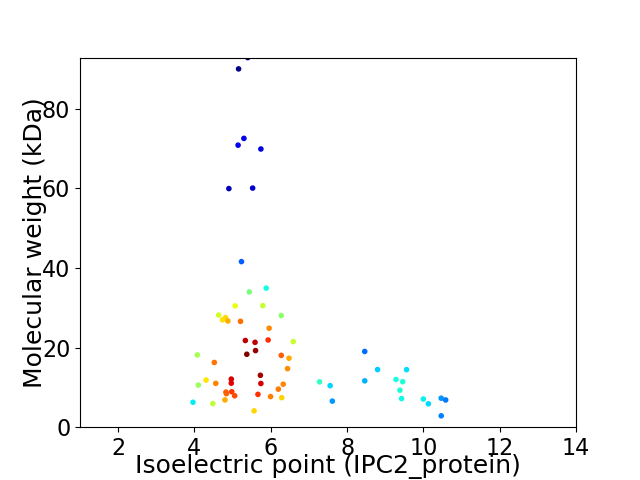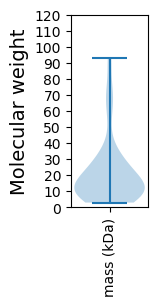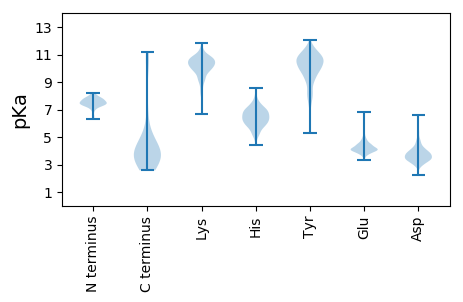
Microbacterium phage Dismas
Taxonomy: Viruses; Duplodnaviria; Heunggongvirae; Uroviricota; Caudoviricetes; Caudovirales; Siphoviridae; Dismasvirus; Microbacterium virus Dismas
Average proteome isoelectric point is 6.23
Get precalculated fractions of proteins

Virtual 2D-PAGE plot for 66 proteins (isoelectric point calculated using IPC2_protein)
Get csv file with sequences according to given criteria:
* You can choose from 21 different methods for calculating isoelectric point
Summary statistics related to proteome-wise predictions



Protein with the lowest isoelectric point:
>tr|A0A2H5BFS9|A0A2H5BFS9_9CAUD Uncharacterized protein OS=Microbacterium phage Dismas OX=2065199 GN=42 PE=4 SV=1
MM1 pKa = 7.84TDD3 pKa = 3.7FQTALDD9 pKa = 3.67EE10 pKa = 4.42HH11 pKa = 7.03LPLRR15 pKa = 11.84TAGALPSTRR24 pKa = 11.84TFGQVEE30 pKa = 4.16EE31 pKa = 4.82ALNSADD37 pKa = 3.19IDD39 pKa = 3.91EE40 pKa = 4.74VKK42 pKa = 11.01AEE44 pKa = 4.07LVHH47 pKa = 6.66TRR49 pKa = 11.84AHH51 pKa = 5.2YY52 pKa = 9.77QALEE56 pKa = 3.81YY57 pKa = 9.93MLNSEE62 pKa = 4.19EE63 pKa = 5.13RR64 pKa = 11.84ILEE67 pKa = 4.41TILAGIARR75 pKa = 11.84DD76 pKa = 3.64AEE78 pKa = 4.32LGEE81 pKa = 4.34EE82 pKa = 4.5AEE84 pKa = 4.63VPAPQTVEE92 pKa = 3.64EE93 pKa = 4.12AVRR96 pKa = 11.84LVVRR100 pKa = 11.84LYY102 pKa = 10.87GSVIVEE108 pKa = 4.15SAYY111 pKa = 9.84DD112 pKa = 3.72TAHH115 pKa = 5.29STGFFMGVLGMDD127 pKa = 4.57LQTSLQNLFGDD138 pKa = 5.06LDD140 pKa = 3.46WSDD143 pKa = 4.12PEE145 pKa = 4.77RR146 pKa = 11.84EE147 pKa = 3.93LSEE150 pKa = 6.15AEE152 pKa = 4.17LQALATPVVDD162 pKa = 4.64TEE164 pKa = 4.38DD165 pKa = 3.1
MM1 pKa = 7.84TDD3 pKa = 3.7FQTALDD9 pKa = 3.67EE10 pKa = 4.42HH11 pKa = 7.03LPLRR15 pKa = 11.84TAGALPSTRR24 pKa = 11.84TFGQVEE30 pKa = 4.16EE31 pKa = 4.82ALNSADD37 pKa = 3.19IDD39 pKa = 3.91EE40 pKa = 4.74VKK42 pKa = 11.01AEE44 pKa = 4.07LVHH47 pKa = 6.66TRR49 pKa = 11.84AHH51 pKa = 5.2YY52 pKa = 9.77QALEE56 pKa = 3.81YY57 pKa = 9.93MLNSEE62 pKa = 4.19EE63 pKa = 5.13RR64 pKa = 11.84ILEE67 pKa = 4.41TILAGIARR75 pKa = 11.84DD76 pKa = 3.64AEE78 pKa = 4.32LGEE81 pKa = 4.34EE82 pKa = 4.5AEE84 pKa = 4.63VPAPQTVEE92 pKa = 3.64EE93 pKa = 4.12AVRR96 pKa = 11.84LVVRR100 pKa = 11.84LYY102 pKa = 10.87GSVIVEE108 pKa = 4.15SAYY111 pKa = 9.84DD112 pKa = 3.72TAHH115 pKa = 5.29STGFFMGVLGMDD127 pKa = 4.57LQTSLQNLFGDD138 pKa = 5.06LDD140 pKa = 3.46WSDD143 pKa = 4.12PEE145 pKa = 4.77RR146 pKa = 11.84EE147 pKa = 3.93LSEE150 pKa = 6.15AEE152 pKa = 4.17LQALATPVVDD162 pKa = 4.64TEE164 pKa = 4.38DD165 pKa = 3.1
Molecular weight: 18.15 kDa
Isoelectric point according different methods:
Protein with the highest isoelectric point:
>tr|A0A2H5BFV6|A0A2H5BFV6_9CAUD Uncharacterized protein OS=Microbacterium phage Dismas OX=2065199 GN=59 PE=4 SV=1
MM1 pKa = 6.94TRR3 pKa = 11.84SHH5 pKa = 6.86AKK7 pKa = 10.19SIARR11 pKa = 11.84SAALTSLAGRR21 pKa = 11.84RR22 pKa = 11.84WGPKK26 pKa = 8.8RR27 pKa = 11.84RR28 pKa = 11.84WRR30 pKa = 11.84CVYY33 pKa = 9.89CGRR36 pKa = 11.84GAGMVVDD43 pKa = 4.01HH44 pKa = 6.6FVPEE48 pKa = 4.13KK49 pKa = 10.63RR50 pKa = 11.84GGEE53 pKa = 3.76DD54 pKa = 3.11TVFNLVPACDD64 pKa = 3.59RR65 pKa = 11.84CNSSKK70 pKa = 10.39QDD72 pKa = 3.71HH73 pKa = 6.36EE74 pKa = 4.24PEE76 pKa = 3.33AWMRR80 pKa = 11.84AVGVPEE86 pKa = 4.05SRR88 pKa = 11.84RR89 pKa = 11.84AALWRR94 pKa = 11.84ILHH97 pKa = 6.22LPSSASLTVPAEE109 pKa = 4.0RR110 pKa = 11.84FEE112 pKa = 4.9LNYY115 pKa = 10.57GAAKK119 pKa = 10.31ALRR122 pKa = 11.84RR123 pKa = 11.84PVQGAKK129 pKa = 10.44GGG131 pKa = 3.66
MM1 pKa = 6.94TRR3 pKa = 11.84SHH5 pKa = 6.86AKK7 pKa = 10.19SIARR11 pKa = 11.84SAALTSLAGRR21 pKa = 11.84RR22 pKa = 11.84WGPKK26 pKa = 8.8RR27 pKa = 11.84RR28 pKa = 11.84WRR30 pKa = 11.84CVYY33 pKa = 9.89CGRR36 pKa = 11.84GAGMVVDD43 pKa = 4.01HH44 pKa = 6.6FVPEE48 pKa = 4.13KK49 pKa = 10.63RR50 pKa = 11.84GGEE53 pKa = 3.76DD54 pKa = 3.11TVFNLVPACDD64 pKa = 3.59RR65 pKa = 11.84CNSSKK70 pKa = 10.39QDD72 pKa = 3.71HH73 pKa = 6.36EE74 pKa = 4.24PEE76 pKa = 3.33AWMRR80 pKa = 11.84AVGVPEE86 pKa = 4.05SRR88 pKa = 11.84RR89 pKa = 11.84AALWRR94 pKa = 11.84ILHH97 pKa = 6.22LPSSASLTVPAEE109 pKa = 4.0RR110 pKa = 11.84FEE112 pKa = 4.9LNYY115 pKa = 10.57GAAKK119 pKa = 10.31ALRR122 pKa = 11.84RR123 pKa = 11.84PVQGAKK129 pKa = 10.44GGG131 pKa = 3.66
Molecular weight: 14.45 kDa
Isoelectric point according different methods:
Peptides (in silico digests for buttom-up proteomics)
Below you can find in silico digests of the whole proteome with Trypsin, Chymotrypsin, Trypsin+LysC, LysN, ArgC proteases suitable for different mass spec machines.| Try ESI |
 |
|---|
| ChTry ESI |
 |
|---|
| ArgC ESI |
 |
|---|
| LysN ESI |
 |
|---|
| TryLysC ESI |
 |
|---|
| Try MALDI |
 |
|---|
| ChTry MALDI |
 |
|---|
| ArgC MALDI |
 |
|---|
| LysN MALDI |
 |
|---|
| TryLysC MALDI |
 |
|---|
| Try LTQ |
 |
|---|
| ChTry LTQ |
 |
|---|
| ArgC LTQ |
 |
|---|
| LysN LTQ |
 |
|---|
| TryLysC LTQ |
 |
|---|
| Try MSlow |
 |
|---|
| ChTry MSlow |
 |
|---|
| ArgC MSlow |
 |
|---|
| LysN MSlow |
 |
|---|
| TryLysC MSlow |
 |
|---|
| Try MShigh |
 |
|---|
| ChTry MShigh |
 |
|---|
| ArgC MShigh |
 |
|---|
| LysN MShigh |
 |
|---|
| TryLysC MShigh |
 |
|---|
General Statistics
Number of major isoforms |
Number of additional isoforms |
Number of all proteins |
Number of amino acids |
Min. Seq. Length |
Max. Seq. Length |
Avg. Seq. Length |
Avg. Mol. Weight |
|---|---|---|---|---|---|---|---|
0 |
13092 |
26 |
876 |
198.4 |
21.57 |
Amino acid frequency
Ala |
Cys |
Asp |
Glu |
Phe |
Gly |
His |
Ile |
Lys |
Leu |
|---|---|---|---|---|---|---|---|---|---|
11.679 ± 0.356 | 0.42 ± 0.082 |
6.141 ± 0.263 | 6.187 ± 0.275 |
3.262 ± 0.163 | 8.899 ± 0.405 |
1.803 ± 0.171 | 3.789 ± 0.178 |
4.125 ± 0.261 | 8.822 ± 0.302 |
Met |
Asn |
Gln |
Pro |
Arg |
Ser |
Thr |
Val |
Trp |
Tyr |
|---|---|---|---|---|---|---|---|---|---|
2.047 ± 0.121 | 2.933 ± 0.23 |
5.225 ± 0.204 | 3.59 ± 0.175 |
6.416 ± 0.387 | 5.568 ± 0.253 |
6.195 ± 0.319 | 8.417 ± 0.339 |
2.055 ± 0.151 | 2.429 ± 0.142 |
Most of the basic statistics you can see at this page can be downloaded from this CSV file
Proteome-pI is available under Creative Commons Attribution-NoDerivs license, for more details see here
| Reference: Kozlowski LP. Proteome-pI 2.0: Proteome Isoelectric Point Database Update. Nucleic Acids Res. 2021, doi: 10.1093/nar/gkab944 | Contact: Lukasz P. Kozlowski |
